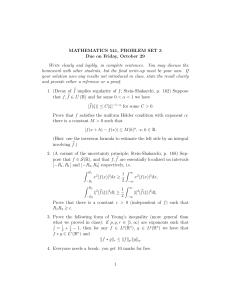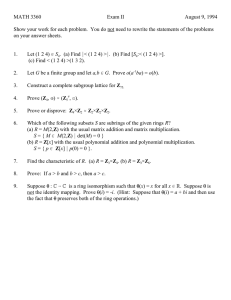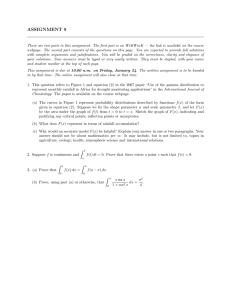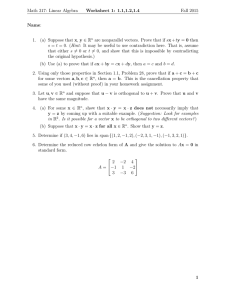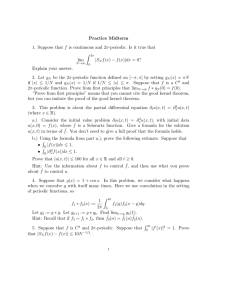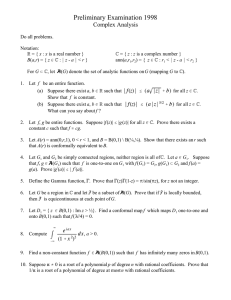Probability Prelim Exam August 2014
advertisement
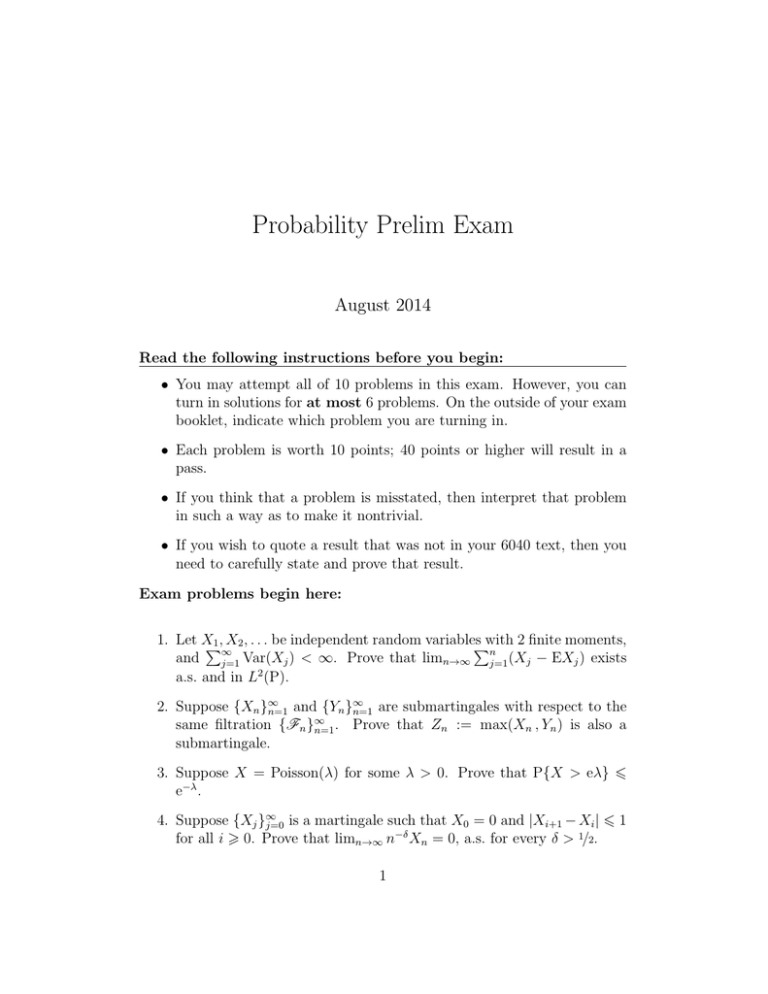
Probability Prelim Exam
August 2014
Read the following instructions before you begin:
• You may attempt all of 10 problems in this exam. However, you can
turn in solutions for at most 6 problems. On the outside of your exam
booklet, indicate which problem you are turning in.
• Each problem is worth 10 points; 40 points or higher will result in a
pass.
• If you think that a problem is misstated, then interpret that problem
in such a way as to make it nontrivial.
• If you wish to quote a result that was not in your 6040 text, then you
need to carefully state and prove that result.
Exam problems begin here:
1. Let X
2 finite moments,
1 , X2 , . . . be independent random variables
P
Pwith
∞
n
and j=1 Var(Xj ) < ∞. Prove that limn→∞ j=1 (Xj − EXj ) exists
a.s. and in L2 (P).
∞
2. Suppose {Xn }∞
n=1 and {Yn }n=1 are submartingales with respect to the
same filtration {Fn }∞
n=1 . Prove that Zn := max(Xn , Yn ) is also a
submartingale.
3. Suppose X = Poisson(λ) for some λ > 0. Prove that P{X > eλ} 6
e−λ .
4. Suppose {Xj }∞
j=0 is a martingale such that X0 = 0 and |Xi+1 − Xi | 6 1
for all i > 0. Prove that limn→∞ n−δ Xn = 0, a.s. for every δ > 1/2.
1
5. Let X1 , X2 , . . . be independent, identically distributed random variables
with the following common distribution:
P{X1 = k} =
3
π2k2
for k = ±1, ±2, . . . .
(a) Prove that E exp(itX1 ) = 1 − (3|t|/π) + o(|t|) as t → 0.
R∞
You may use, without proof, the fact that 0 (1 − cos θ)θ−2 dθ =
π/2.
(b) Use the preceding in order to prove that n−1 (X1 + · · · + Xn ) converges weakly to a “Cauchy random variable Y with scale parameter 3/π.” That is, the characteristic function of Y is
E exp(itY ) = exp(−3|t|/π)
for all t ∈ R.
You may use, without proof, the fact that the latter is a characteristic function. This matter is the topic of Problem 8 below.
6. Let X1 , X2 , . . . be i.i.d. integer-valued random variables with probability mass function f (a) := P{X1 = a} for all a ∈ Z, and suppose
f (a) > 0 for all a ∈ Z. Now let g be another probability mass function
on Z and define the likelihood ratio,
n
Y
g(Xj )
.
Λn :=
f (Xj )
j=1
(a) Consider the log-likelihood log Λn , where “log” denotes the natural
logarithm. Prove that limn→∞ n−1 log Λn = D(g k f ) a.s., where
∞
X
g(a)
D(g k f ) :=
f (a) log
,
f (a)
a=−∞
provided that E(g k f ) :=
P∞
a=−∞
| log[g(a)/f (a)]|f (a) < ∞.
(b) Verify that log x 6 x − 1 for all x > 0, and that the inequality is
strict except when x = 1. Use this to prove the following [Gibbs’
inequality]: D(g k f ) < 0.
2
(c) Conclude from the preceding that if E(g k f ) < ∞, then Λn → 0
a.s. very rapidly as n → ∞.
This fact plays an important role in statistics.
7. Suppose f : [0 , ∞) → R is bounded and measurable, and f (x) = 0 for
all x > 2.
(a) Prove that if X1 , X2 , . . . are independent, all distributed uniformly
in the interval (0 , 1), then
Z ∞
n
j + Xj
1X
P
f
−→
f (x) dx
as n → ∞.
n j=0
n
0
(b) (Extra credit) Deduce from this the following version of Riemann
sums for Lebesgue integrals [Chaterjee’s theorem]: There exists a
sequence {δj,n ; 0 6 j 6 n, n > 1} of real numbers in (0 , 1) such
that
Z ∞
n
j + δj,n
1X
lim
f
=
f (x) dx.
n→∞ n
n
0
j=0
1
8. Let f be a continuous
R ∞ element of L (R), and recall that its Fourier
transform is fˆ(t) := −∞ exp(itx)f (x) dx.
(a) Suppose also that fˆ ∈ L1 (R). Prove the following [inversion
formula]:
Z ∞
1
e−ixt fˆ(t) dt
for all x ∈ R.
f (x) =
2π −∞
b
In other words, fˆ(−x) = 2πf (x) for all x ∈ R.
(b) Choose and fix some θ > 0. Use the preceding to prove that the
Fourier transform of the probability density function
f (x) :=
π(θ2
θ
+ x2 )
is fˆ(t) = exp(−θ|t|).
3
[−∞ < x < ∞]
9. Suppose X and Y are i.i.d. random variables and f and g are nondecreasing, bounded and measurable functions on R.
(a) Prove that E[(f (X) − f (Y ))(g(X) − g(Y ))] > 0.
(b) Conclude that f (X) and g(X) are always positively correlated;
i.e., E[f (X)g(X)] > E[f (X)] · E[g(X)].
10. Let Z = N(0 , 1) denote a standard normal random variable. Suppose
f : R → R is continuously differentiable and there exists c > 1 such
that |f (x)| + |f 0 (x)| 6 c exp(c|x|) for all x ∈ R. Derive the following
[Stein’s differential equation]: E[f 0 (Z)] = E[Zf (Z)].
4

